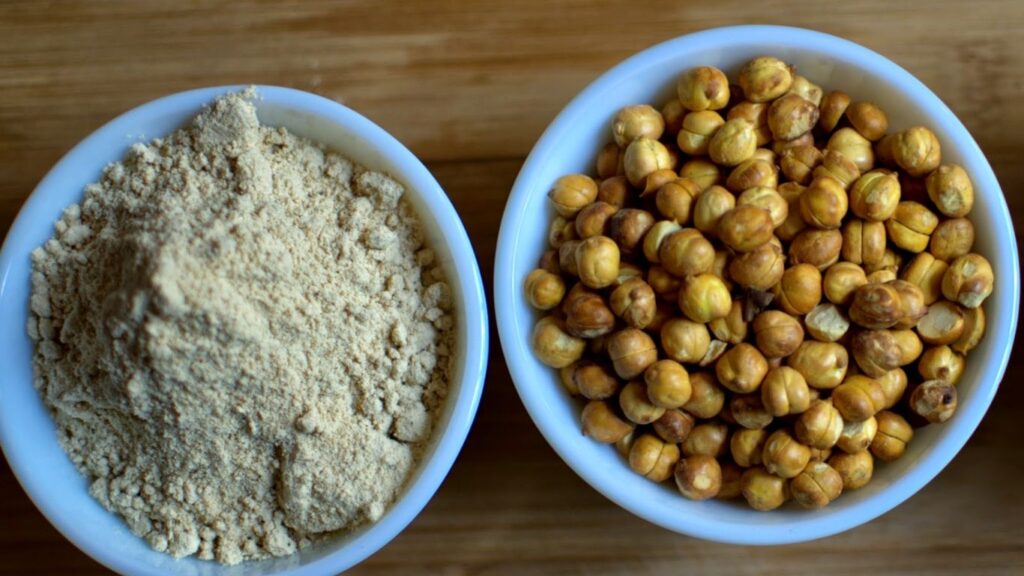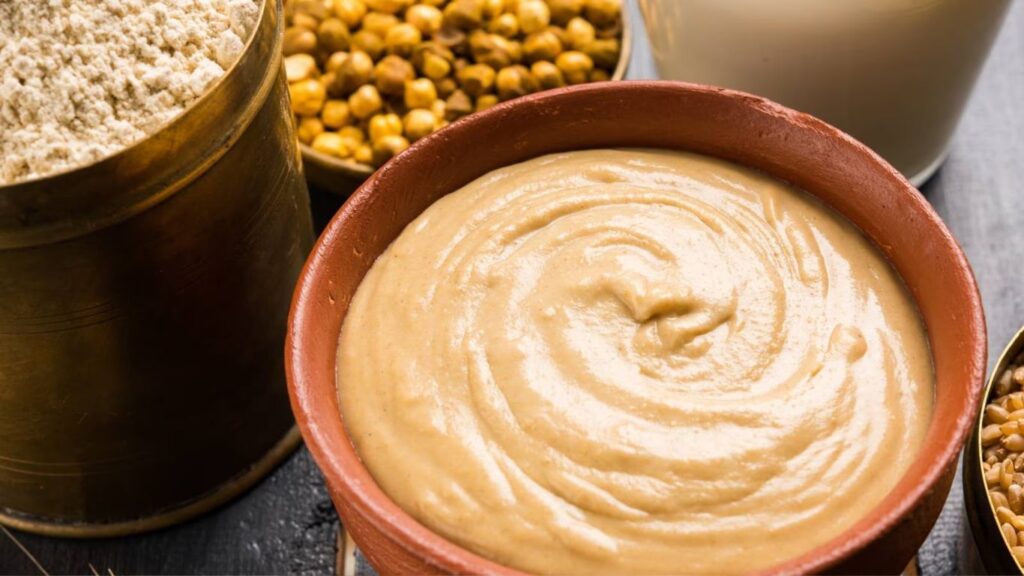During a backpacking trip through India, I stumbled upon a bustling street market, where the aroma of freshly ground spices led me to a humble stall. There, I encountered roasted gram flour for the first time, a golden powder that the vendor praised as a protein powerhouse. This discovery was a revelation. Back home, as a vegan, I’d often faced the skeptical query: “But where do you get your protein?” The common misconception that a vegan diet can’t adequately provide protein had always been a challenge to navigate. Yet, here was roasted gram flour, an unassuming but versatile ingredient boasting not just high protein content but a rich array of other nutrients. This encounter marked the beginning of my journey into exploring roasted gram flour’s potential, from its role in traditional dishes to its modern-day incarnation as a vegan dietary staple, showcasing its incredible benefits and versatility.
Table of contents
The Nutritional Power of Roasted Gram Flour
Roasted gram flour, also known as Sattu , is made from ground, roasted chickpeas. Originating from the Indian subcontinent, it has been a staple in South Asian cuisine for centuries, used in everything from savory dishes like pakoras and curries to sweet treats like laddoos. This flour is not just a culinary chameleon; it’s a nutritional titan. Per 100 grams, it boasts approximately 22 grams of protein, eclipsing other vegan favorites like quinoa and tofu. This makes it an exceptional choice for those seeking to boost their protein intake without resorting to animal products.
Beyond its impressive protein content, roasted gram flour is rich in dietary fiber, aiding in digestion and promoting a feeling of fullness. It’s also packed with vital vitamins and minerals, including iron, magnesium, and B vitamins, essential for energy production and overall health. Additionally, its low glycemic index makes it an excellent option for maintaining stable blood sugar levels, beneficial for everyone, especially those managing diabetes. This combination of high nutritional value and health benefits makes roasted gram flour a superior ingredient in the vegan pantry, offering a wholesome alternative to more processed protein sources.

Why Protein Matters in a Vegan Diet
Protein is fundamental to overall health, playing a crucial role in building, repairing, and maintaining muscle tissue. It’s not just about muscle mass; protein is also essential for a healthy metabolism, aiding in the efficient functioning of enzymes and hormones throughout the body. Despite its importance, vegan diets often face scrutiny over protein sufficiency, with a prevailing misconception that plant-based sources can’t meet the body’s protein needs. This skepticism overlooks the diversity and richness of plant-based proteins, which can fully satisfy dietary requirements when carefully chosen.
High-quality plant-based proteins, such as roasted gram flour, quinoa, lentils, and tofu, are not only abundant in protein but also provide a wide array of other nutrients vital for health, including fiber, vitamins, and minerals. These sources are integral to a balanced vegan diet, ensuring nutritional adequacy without the need for animal products. The key lies in diversity and mindfulness in selecting a variety of plant-based proteins to cover the spectrum of essential amino acids, akin to building blocks for the body. By dispelling the myth of protein deficiency in vegan diets, we can appreciate the abundance of nutritious, plant-based options that support health, muscle maintenance, and a robust metabolism.
Including Roasted Gram Flour into Your Vegan Diet
Incorporating roasted gram flour into daily meals is a straightforward and delicious way to enhance your diet with high-quality plant-based protein. Its versatility makes it a seamless addition to a myriad of dishes, across various cuisines.
Breakfast: Start your day with a protein-packed pancake by substituting traditional flour with roasted gram flour. Add a dash of cinnamon and vanilla for a flavorful twist. These pancakes are not only nutritious but also gluten-free, making them suitable for a wider audience.

Lunch: For a hearty lunch, try making a chickpea flour-based quiche or frittata. Mix roasted gram flour with water to create a batter, then add your choice of vegetables and bake. It’s an excellent way to include more protein in your midday meal without relying on meat or dairy.
Dinner: Use roasted gram flour to thicken soups and stews, adding a nutty flavor and a protein boost. Alternatively, prepare a traditional Indian besan curry, which showcases the flour’s ability to absorb flavors and contribute to a rich, satisfying dish.
Snacks: For an easy snack, make savory chickpea flour crackers seasoned with herbs and spices. They’re perfect for dipping or as a standalone snack.
Testimonials: Many who’ve transitioned to including roasted gram flour in their diet report not only enjoying the diverse flavors it brings to their meals but also noticeable health benefits such as improved digestion and sustained energy levels. A reader shared, “Switching to roasted gram flour was a game-changer for my vegan diet. It’s not only elevated my cooking with its unique taste but has also made me feel more energized and satiated throughout the day.
Overcoming Challenges and Making the Switch
Adding roasted gram flour into your diet can come with its set of challenges, including availability, adapting to its unique taste, and modifying recipes. However, these hurdles can be easily overcome with a bit of know-how and creativity.
Availability: While roasted gram flour is a staple in South Asian stores, it might not be as readily available in mainstream supermarkets. The solution? Look for it in health food stores, international markets, or online retailers, where it’s often sold under names like besan or chickpea flour.
Taste Preferences: The distinct, nutty flavor of roasted gram flour may be new to some palates. Begin by mixing it with other flours in recipes, gradually increasing the proportion as your taste adjusts. This method works well for baked goods, pancakes, and thickening agents for soups and sauces.
Adapting Recipes: Not all recipes may take kindly to a straight substitution with roasted gram flour due to its unique properties. Start with recipes that naturally call for it or ones specifically designed for gluten-free cooking. Experimenting with spice blends can also help mask any unfamiliar tastes and make the transition smoother.
Adjusting Flavors: Roasted gram flour pairs well with strong flavors and spices. If you’re using it in savory dishes, don’t hesitate to add an extra pinch of your favorite seasonings. For sweet recipes, incorporating ingredients like cocoa powder or sweet spices (cinnamon, nutmeg) can enhance the overall flavor profile.

Supporting Sustainability Through Your Diet
Choosing plant-based proteins like roasted gram flour offers significant environmental benefits, contributing to a more sustainable planet. The production of plant-based proteins generally requires less water, land, and energy compared to animal-based proteins, leading to a lower carbon footprint. Additionally, plant-based agriculture promotes soil health and biodiversity. By opting for plant-based proteins, individuals can play a crucial role in reducing greenhouse gas emissions, conserving natural resources, and mitigating climate change. It’s an invitation to reflect on the broader impact of our food choices, understanding that each meal can be a step towards global sustainability.
Conclusion:
Embrace roasted gram flour in your diet not only for its impressive protein profile but also for its countless health benefits and positive environmental footprint. This versatile ingredient can enrich your meals with nutrients while supporting a more sustainable world. We encourage you to experiment, share your experiences, and swap recipes. Have questions or innovative uses for roasted gram flour? Let’s create a vibrant community dialogue. Together, we can explore the delicious possibilities and make a difference—one meal at a time.
Also read: Recognizing the Red Flags: A Guide to Heat Stroke Symptoms and Immediate Actions
